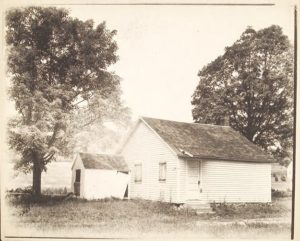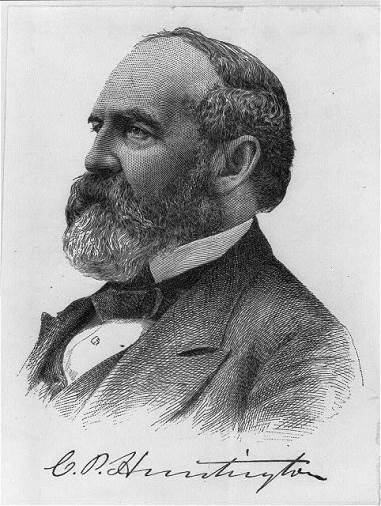By Nancy Finlay
South of Route 4 in Harwinton, Connecticut, where a small stream called Huntington Brook flows into Leadmine Brook, is an area once known as Poverty Hollow. Here, in the early years of the 19th century, William H. Huntington had a 30-acre farm, and he lived with his wife Elizabeth Vincent Huntington and their nine children (three sons and six daughters). The sixth child, born on October 22, 1821, they christened Collis Potter Huntington.
Growing Up in Harwinton

Poverty Hollow School, Harwinton, Connecticut – Connecticut State Library, Mills Photograph Collection of Connecticut, 1895-1955 (PG 180)
Growing up, times were hard and the Huntington’s farm did not prosper. Neither did a fulling mill and a shingle mill which Huntington’s father operated. The children had to help out on the farm and in the mills, and their schooling, in the local one-room schoolhouse, became irregular. Collis did well in arithmetic, history, and geography, but not in spelling or grammar. He was a big boy and an unruly student, who, when his teacher tried to strike him with a ruler as a punishment, turned on the teacher and fought back.
Another teacher remembered Collis as “very poorly clothed, and not well cared for.” The Huntingtons became so poor and destitute that in 1834 the town selectmen removed Collis and his older brother from the family home and placed them with local farmers. Collis worked for Orson Barber for a year, earning seven dollars a month, then went to work for another neighbor, Phineas Noble, who ran a small store. Part of the time the boy worked as a peddler, selling merchandise from door to door in northwestern Connecticut. Later, still in his teens, he branched out on his own, selling clocks and “Yankee notions” in the South.
Meanwhile, Collis’s older brother Solon left Connecticut and established a store in Oneonta, New York. In 1844, Collis joined him, investing his surprisingly substantial savings in the business, which then became S. & C. P. Huntington. The same year, on September 18, Collis married a distant cousin, Elizabeth Stoddard, of Cornwall, Connecticut. (The marriage lasted until Elizabeth’s death in 1883.)
Collis Huntington and the Central Pacific Railroad

Collis Potter Huntington, 1821-1900 – Library of Congress, Prints and Photographs Division
S. & C. P. Huntington quickly became the most successful store in Otsego County. Solon and Collis were both prosperous and respected, but Collis was not content. Like many other young Americans in 1848–1849, he headed west for California upon learning of the discovery of gold at Sutter’s Mill. Unlike most of the others, however, who headed straight for the gold fields, Collis opened a store in Sacramento selling mining equipment. While most of the miners wound up broke, Collis Huntington amassed a small fortune. This became the basis for a very large fortune, when, in the 1860s, Huntington became involved in building the Central Pacific Railroad—the line which ran east from California to meet up with Union Pacific, creating the first transcontinental railroad. Huntington’s empire eventually went on to include the Southern Pacific Railroad and the Pacific Mail Steamship Company (though many criticized it as built on the typically disingenuous practices of a “robber baron,” such as bribing politicians and withholding dividend payments from minority stockholders).
Despite his success, Huntington never not forget his Connecticut origins. In 1885, he proposed building a chapel behind the Congregational Church in Harwinton in memory of his mother. The little Gothic chapel, with lovely stained glass windows, reached completion in 1887. At its dedication, Huntington, then 66 years old, recalled how his mother, “one of the best women that ever lived,” often “worked into the small hours of the night that her children might be comfortably clothed on the morrow.” He referred bitterly to his forced removal from the family in 1834, saying that “the Harwinton selectmen did not consult Solon or myself or our parents about taking us away from our home . . . We were rudely moved and had to like it.” Nevertheless, he concluded that “as often as I have returned to these my native hills have I been made glad that this was the place where I was born, and that I was born poor, for I think that was the reason, at least in part, of such success in life as I have been able to achieve.” His was the classic success story—a poor boy who grew up to be one of the most powerful and important men in America.
Collis Huntington died on August 13, 1900, at his Great Camp in the Adirondacks. He received a burial in Woodlawn Cemetery in New York City. The chapel that he gave in memory of his mother fell into disrepair and was torn down in 1960. At about the same time, the Army Corps of Engineers acquired Poverty Hollow for a flood control project. Huntington’s birthplace had long since been torn down; the remaining houses and other buildings were demolished or moved from the area too and the valley eventually reverted back to forest.
Nancy Finlay grew up in Manchester, Connecticut. She has a BA from Smith College and an MFA and PhD from Princeton University. From 1998 to 2015, she was Curator of Graphics at the Connecticut Historical Society.








